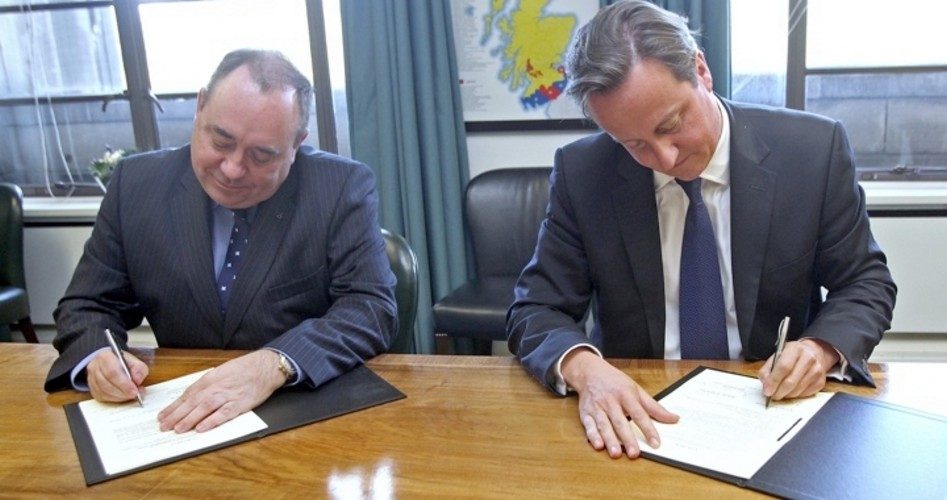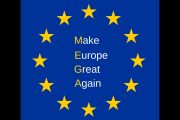
Meeting at St Andrew’s House, the Scottish government building, in Edinburgh on October 15, the United Kingdom’s Prime Minister David Cameron and the First Minister of Scotland, Alex Salmond, signed an agreement allowing the Scottish people to hold a referendum in Autumn 2014 to decide whether Scotland should remain in the U.K. or opt for independence.
BBC News explained that the U.K. government has responsibility over the kingdom’s constitutional issues and will “grant limited powers to the Scottish Parliament to hold a legal referendum, under a mechanism called Section 30.”
Following the signing of the agreement, Salmond said:
I’m delighted to say that the Edinburgh agreement … paves the way for the most important decision Scotland has made in several hundred years.
I believe that independence will win this campaign. I believe we’ll win it by setting out a better future for our country.
According to BBC News, the agreement provides for:
• A statutory order to be legislated at Westminster, granting Holyrood [the area of Edinburgh containing the Scottish parliament] powers to hold a single-question independence referendum by the end of 2014 and covering other issues like campaign broadcasts.
• A “memorandum of agreement” to be signed by political leaders confirming the details of the referendum to be settled at Holyrood.
• A significant role for the Electoral Commission watchdog in advising on the wording of the question, the running of the referendum and areas including campaign finance.
Cameron, who personally opposes Scottish independence, told the press:
This is an important day for our United Kingdom, but you can’t hold a country in the United Kingdom against the will of its people.
Scotland voted for a party that wanted to hold a referendum. I believe in showing respect. This is the right outcome for Scotland and for the United Kingdom to give the people the choice.
But I passionately hope and believe that they will vote to keep the United Kingdom together. We are better off together, we are stronger together, we are safer together.
The party that Cameron referred to is the Scottish National Party (SNP), the majority party in Edinburgh’s devolved (created by the British crown) parliament, which was established by the Scotland Act of 1998. Wikipedia notes: “Popular arguments against the Parliament before the UK general election of 1997, levelled by the Conservative Party, were that the Parliament would create a ‘slippery slope’ to Scottish independence, and provide the pro-independence Scottish National Party with a route to power.”
A survey conducted by the ComRes market research agency for Britain’s ITV News released on October 15 showed 34 percent of Scots (and 29 percent of Britons) in favor of Scottish independence, so the SNP has considerable work ahead if it hopes to achieve the mandate required for independence. An AFP report noted: “The SNP had pressed for the 2014 date, giving them time to try to win over voters and coinciding with the anniversary of the 1314 Battle of Bannockburn, a famous Scots victory over the English.”
The AFP report cited Salmond’s statement that, should the referendum pass, Scotland would hold its first parliamentary elections in 2016, followed by drafting a written constitution.
“It’s a historic day for Scotland,” a Reuters report quoted Salmond after he signed the deal with Prime Minister Cameron. “Do I think we can win this campaign? Yes, I do.”
Reuters reported a statement made by a young “man on the street,” Murray Poole, of Edinburgh: “I consider myself British and I prefer to stay British. I was in the British army fighting on the side of the English and the Welsh and the Northern Irish. But some of my friends are up for it (independence), they don’t like England … They want to become Scottish,” said Poole.
As part of the agreement, Scotland will lower its voting age from 18 to 16, a move considered favorable to a “yes” vote, since Salmond believes that Scottish youth are more pro-independence than their elders.
Scotland’s political union with Britain dates back to July 22, 1706, when the Treaty of Union was agreed upon between representatives of the Scots Parliament and the Parliament of England. In the following year twin Acts of Union were passed by both parliaments to create the Kingdom of Great Britain, which took effect on May 1, 1707.
One of the leading causes of support for Scottish union with Britain was a widespread economic crisis in Scotland that began in 1698, when a scheme to establish a Scottish trading colony on the Isthmus of Panama failed miserably, reducing many investors to bankruptcy. Members of Scotland’s elite believed that union with England would solve their economic woes, and they traded national sovereignty for economic security.
Now, three centuries later, a movement to restore Scottish independence has shown promise. But whether today’s Scots will decide that political independence is preferable to the possible economic benefits of remaining united to England remains to be seen. One factor that may decide the outcome, in Scottish minds, is whether a greater share of North Sea oil revenue from Scottish waters will benefit Scotland more than any disadvantages of going it alone. Wikipedia notes: “If Scotland became independent, it would hold 90% of the UK’s current oil and gas reserves if they were split geographically using a median line from the English-Scottish border. If the reserves were to be split by population, that figure would be reduced to 9%.”
Photo: Britain’s Prime Minister David Cameron, right, and Scotland’s First Minister Alex Salmond, sign a referendum agreement during a meeting at St Andrews House in Edinburgh, Oct. 15, 2012: AP Images



